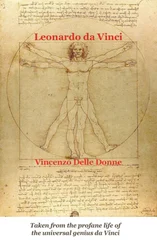Leonardo da Vinci - The Notebooks of Leonardo Da Vinci. Complete
Здесь есть возможность читать онлайн «Leonardo da Vinci - The Notebooks of Leonardo Da Vinci. Complete» — ознакомительный отрывок электронной книги совершенно бесплатно, а после прочтения отрывка купить полную версию. В некоторых случаях можно слушать аудио, скачать через торрент в формате fb2 и присутствует краткое содержание. Жанр: foreign_prose, foreign_home, visual_arts, foreign_antique, на английском языке. Описание произведения, (предисловие) а так же отзывы посетителей доступны на портале библиотеки ЛибКат.
- Название:The Notebooks of Leonardo Da Vinci. Complete
- Автор:
- Жанр:
- Год:неизвестен
- ISBN:нет данных
- Рейтинг книги:3 / 5. Голосов: 1
-
Избранное:Добавить в избранное
- Отзывы:
-
Ваша оценка:
- 60
- 1
- 2
- 3
- 4
- 5
The Notebooks of Leonardo Da Vinci. Complete: краткое содержание, описание и аннотация
Предлагаем к чтению аннотацию, описание, краткое содержание или предисловие (зависит от того, что написал сам автор книги «The Notebooks of Leonardo Da Vinci. Complete»). Если вы не нашли необходимую информацию о книге — напишите в комментариях, мы постараемся отыскать её.
The Notebooks of Leonardo Da Vinci. Complete — читать онлайн ознакомительный отрывок
Ниже представлен текст книги, разбитый по страницам. Система сохранения места последней прочитанной страницы, позволяет с удобством читать онлайн бесплатно книгу «The Notebooks of Leonardo Da Vinci. Complete», без необходимости каждый раз заново искать на чём Вы остановились. Поставьте закладку, и сможете в любой момент перейти на страницу, на которой закончили чтение.
Интервал:
Закладка:
87
How every large mass sends forth its images, which may diminish through infinity.
The images of any large mass being infinitely divisible may be infinitely diminished.
88
Objects of equal size, situated in various places, will be seen by different pyramids which will each be smaller in proportion as the object is farther off.
89
Perspective, in dealing with distances, makes use of two opposite pyramids, one of which has its apex in the eye and the base as distant as the horizon. The other has the base towards the eye and the apex on the horizon. Now, the first includes the [visible] universe, embracing all the mass of the objects that lie in front of the eye; as it might be a vast landscape seen through a very small opening; for the more remote the objects are from the eye, the greater number can be seen through the opening, and thus the pyramid is constructed with the base on the horizon and the apex in the eye, as has been said. The second pyramid is extended to a spot which is smaller in proportion as it is farther from the eye; and this second perspective [= pyramid] results from the first.
90
SIMPLE PERSPECTIVE.
Simple perspective is that which is constructed by art on a vertical plane which is equally distant from the eye in every part. Complex perspective is that which is constructed on a ground-plan in which none of the parts are equally distant from the eye.
91
PERSPECTIVE.
No surface can be seen exactly as it is, if the eye that sees it is not equally remote from all its edges.
92
WHY WHEN AN OBJECT IS PLACED CLOSE TO THE EYE ITS EDGES ARE INDISTINCT.
When an object opposite the eye is brought too close to it, its edges must become too confused to be distinguished; as it happens with objects close to a light, which cast a large and indistinct shadow, so is it with an eye which estimates objects opposite to it; in all cases of linear perspective, the eye acts in the same way as the light. And the reason is that the eye has one leading line (of vision) which dilates with distance and embraces with true discernment large objects at a distance as well as small ones that are close. But since the eye sends out a multitude of lines which surround this chief central one and since these which are farthest from the centre in this cone of lines are less able to discern with accuracy, it follows that an object brought close to the eye is not at a due distance, but is too near for the central line to be able to discern the outlines of the object. So the edges fall within the lines of weaker discerning power, and these are to the function of the eye like dogs in the chase which can put up the game but cannot take it. Thus these cannot take in the objects, but induce the central line of sight to turn upon them, when they have put them up. Hence the objects which are seen with these lines of sight have confused outlines.
The relative size of objects with regard to their distance from the eye (93-98).
93
PERSPECTIVE.
Small objects close at hand and large ones at a distance, being seen within equal angles, will appear of the same size.
94
PERSPECTIVE.
There is no object so large but that at a great distance from the eye it does not appear smaller than a smaller object near.
95
Among objects of equal size that which is most remote from the eye will look the smallest. [Footnote: This axiom, sufficiently clear in itself, is in the original illustrated by a very large diagram, constructed like that here reproduced under No. 108.
The same idea is repeated in C. A. I a; I a, stated as follows: Infra le cose d'equal grandeza quella si dimostra di minor figura che sara piů distante dall' ochio .—]
96
Why an object is less distinct when brought near to the eye, and why with spectacles, or without the naked eye sees badly either close or far off [as the case may be].
97
PERSPECTIVE.
Among objects of equal size, that which is most remote from the eye will look the smallest.
98
PERSPECTIVE.
No second object can be so much lower than the first as that the eye will not see it higher than the first, if the eye is above the second.
PERSPECTIVE.
And this second object will never be so much higher than the first as that the eye, being below them, will not see the second as lower than the first.
PERSPECTIVE.
If the eye sees a second square through the centre of a smaller one, that is nearer, the second, larger square will appear to be surrounded by the smaller one.
PERSPECTIVE—PROPOSITION.
Objects that are farther off can never be so large but that those in front, though smaller, will conceal or surround them.
DEFINITION.
This proposition can be proved by experiment. For if you look through a small hole there is nothing so large that it cannot be seen through it and the object so seen appears surrounded and enclosed by the outline of the sides of the hole. And if you stop it up, this small stopping will conceal the view of the largest object.
The apparent size of objects defined by calculation (99-105)
99
OF LINEAR PERSPECTIVE.
Linear Perspective deals with the action of the lines of sight, in proving by measurement how much smaller is a second object than the first, and how much the third is smaller than the second; and so on by degrees to the end of things visible. I find by experience that if a second object is as far beyond the first as the first is from the eye, although they are of the same size, the second will seem half the size of the first and if the third object is of the same size as the 2nd, and the 3rd is as far beyond the second as the 2nd from the first, it will appear of half the size of the second; and so on by degrees, at equal distances, the next farthest will be half the size of the former object. So long as the space does not exceed the length of 20 braccia. But, beyond 20 braccia figures of equal size will lose 2/4 and at 40 braccia they will lose 9/10, and 19/20 at 60 braccia, and so on diminishing by degrees. This is if the picture plane is distant from you twice your own height. If it is only as far off as your own height, there will be a great difference between the first braccia and the second.
[Footnote: This chapter is included in DUFRESNE'S and MANZI'S editions of the Treatise on Painting. H. LUDWIG, in his commentary, calls this chapter " eines der wichtigsten im ganzen Tractat ", but at the same time he asserts that its substance has been so completely disfigured in the best MS. copies that we ought not to regard Leonardo as responsible for it. However, in the case of this chapter, the old MS. copies agree with the original as it is reproduced above. From the chapters given later in this edition, which were written at a subsequent date, it would appear that Leonardo corrected himself on these points.]
100
OF THE DIMINUTION OF OBJECTS AT VARIOUS DISTANCES.
A second object as far distant from the first as the first is from the eye will appear half the size of the first, though they be of the same size really.
OF THE DEGREES OF DIMINUTION.
If you place the vertical plane at one braccio from the eye, the first object, being at a distance of 4 braccia from your eye will diminish to 3/4 of its height at that plane; and if it is 8 braccia from the eye, to 7/8; and if it is 16 braccia off, it will diminish to 15/16 of its height and so on by degrees, as the space doubles the diminution will double.
Читать дальшеИнтервал:
Закладка:
Похожие книги на «The Notebooks of Leonardo Da Vinci. Complete»
Представляем Вашему вниманию похожие книги на «The Notebooks of Leonardo Da Vinci. Complete» списком для выбора. Мы отобрали схожую по названию и смыслу литературу в надежде предоставить читателям больше вариантов отыскать новые, интересные, ещё непрочитанные произведения.
Обсуждение, отзывы о книге «The Notebooks of Leonardo Da Vinci. Complete» и просто собственные мнения читателей. Оставьте ваши комментарии, напишите, что Вы думаете о произведении, его смысле или главных героях. Укажите что конкретно понравилось, а что нет, и почему Вы так считаете.












